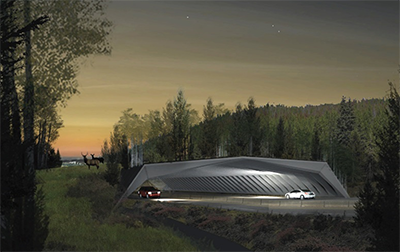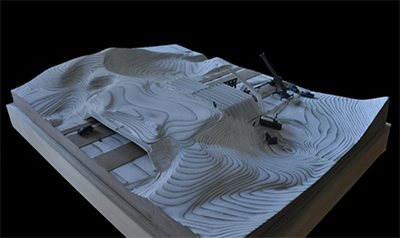
Interdisciplinary Partnerships Help to Connect Ecosystems and
Improve Roadway Safety for Wildlife and the Traveling Public
For years, wildlife-vehicle collisions (WVCs) have endangered the driving public and wildlife along the Nation's roadways, but policymakers and practitioners have had little information on the size and scope of the problem. To better understand the challenge, in 2005 legislators directed the Secretary of Transportation to conduct a national study evaluating WVCs in the Safe, Accountable, Flexible, Efficient Transportation Equity Act: A Legacy for Users (SAFETEA-LU).
With funding from the Federal Highway Administration (FHWA), the Western Transportation Institute (WTI) at Montana State University conducted a national study on WVCs mitigation methods in response to the SAFETEA-LU directive. WTI concluded that implementation of WVCs mitigation methods was stagnant because there was (1) little reliable information on mitigation measures; (2) no standardized performance measures for tracking reductions in WVCs; (3) inconsistent location-specific WVCs data; and (4) no WVCs data present in crash models.
WTI is one of several research organizations working to better understand WVCs and to establish ways to address the challenges they create. The Transportation Research Board Subcommittee on Animal-Vehicle Collisions, ANB20(2), works to mitigate safety hazards caused by animals on roadways and the detrimental effects on sustainable animal populations.Animal Road Crossing (ARC) Solutions, a coalition of partners across the public, private, nonprofit, and higher education sectors in the U.S. and Canada, helps put research from organizations like WTI and ANB20(2) into practice. Over the past few years, ARC has established a strong network of subject-matter experts and practitioners who are facilitating conversations about WVCs mitigation methods and implementing cost-effective solutions.
Public and Private Partners Lay Foundation for Advancing Innovations in Wildlife Crossings
ARC launched in 2010 to make North American highways safer for both people and wildlife. Its purpose is to develop and implement solutions to improve human and wildlife mobility and landscape connectivity by providing technical assistance and expertise to Federal, State, local, and provincial transportation planning agencies.

Graphic representation of the winning team's modular hypar vault system. One benefit of the design is that it isolates animals from road light and noise. (courtesy of HNTB and MVVA)
ARC sponsored the world's first International Wildlife Crossing Infrastructure Design Competition. The contest was intended to help move the state of the practice in wildlife crossing implementation forward by engaging interdisciplinary teams that included landscape architects, engineers, transportation planners, and ecologists to develop solutions for animal road crossing structures that would be cost efficient, ecologically responsive, safe, educational, and flexible. Attracting 36 teams from nine countries, a jury of experts selected the winning design by HNTB and Michael Van Valkenburgh Associates (MVVA).
Known as “hypar vault,” the winning design combines three structural bridge components that are usually manufactured separately into a single modular element that is more cost effective and can be expanded or adapted as migration pressures dictate. The hypar vault design, which can be deployed with minimal site disturbance, has since inspired new precast designs for wildlife crossings. Hypar vault and other design innovations resulting from the competition are being used to start conversations about real-world applications to create safe passage for roadway users and wildlife.
Following the competition, ARC expanded its mission to include knowledge-sharing and building support for implementing wildlife crossings. ARC is a network of partners who are all motivated to increase awareness that wildlife crossings provide safe movement for both people and animals: to reduce costs of effective crossing structures, and to promote sound, scientific, and innovative engineering solutions that improve the quality of wildlife mitigation projects and products.
These efforts are driven by ARC's intention to improve economic, environmental, and social outcomes, also known as the triple bottom line. Thus far, ARC has achieved its goals through the following activities:
- Hosting a Cultures and Crossings Forum at the 2013 International Conference on Ecology and Transportation to understand beliefs and attitudes affecting consideration of wildlife crossings as life-saving measures that improve connectivity across human and natural environments. Representatives of Departments of Transportation (DOTs) from eight U.S. States (Arizona, Colorado, Idaho, Maine, Massachusetts, Montana, Nebraska, and Wyoming); two provincial agencies (Alberta Transportation and Parks Canada); and three U.S. Federal agencies (FHWA, the U.S. Fish and Wildlife Service, and the U.S. Forest Service) attended.
- Producing Wildlife Crossing Design Recommendations: Innovations in Overpass Design, a booklet that illustrates the innovative design techniques developed during the aforementioned design competition, with the goal of working with U.S. and Canadian transportation officials to build one or more next-generation wildlife crossings.
- Providing design and technical analyses to U.S. and provincial entities interested in adapting the winning ARC competition design (by HNTB with MVVA) to one or more wildlife crossing sites.
- Sponsoring a survey of over 500 individuals from 50 State DOTs entitled “Implementing Wildlife Crossing Infrastructure: Understanding DOT Culture,” which reports on State DOT culture regarding implementation of wildlife crossing infrastructure during planning and project development.
- Providing funding to support Colorado Parks and Wildlife's pre- and post-construction monitoring of wildlife crossings to be built along Highway 9 near Kremmling, Colorado.
- Partnering with Ryerson University to co-produce XING, an educational, interactive public exhibit that engages the public on the ways humans and wildlife collide, converge, and ultimately reconnect. XING was exhibited in 2013 at the Evergreen Brickworks Centre for Green Cities in Toronto and is scheduled to become a permanent exhibit at the Toronto Zoo in summer 2016.
ARC received a 2015 Environmental Excellence Award (EEA) from FHWA's EEA program, which acknowledges partners, projects, and processes that protect and enhance the environment while meeting transportation needs. ARC won an EEA for Environmental Leadership because it promotes solutions to improve human safety, wildlife mobility, and long-term landscape connectivity during transportation project planning and development through interdisciplinary partnerships among private companies and public agencies. The award emphasizes the significance of how these partnerships are successfully developing innovative ways to reduce conflicts between animals and motorists.
Collaborative, Informal Structure Promotes Fast and Cost-Effective Solutions for Partners

Model of the winning hypar vault design. Modules are optimized to be efficiently transported, erected, combined, and re-combined, so that bridge sections may be added or removed as animal migration pressures shift over time. (courtesy of HNTB and MVVA)
Through its goals to innovate, educate, and motivate, ARC strives to identify global best practices in wildlife crossings, educate stakeholders about the costs of WVCs and the cost-savings that new innovations provide, and motivate the public and practitioners to take action to reduce WVCs using the latest innovations. ARC works for safe passage through three core initiatives: communications, technology transfer, and implementation. These initiatives guide the outreach, technical assistance, design innovation, and product development work conducted by ARC members, but much of ARC's achievements are grounded in informal collaboration and communications among members.
ARC encourages collaboration among its members by promoting informal idea- and information-sharing. For example, when an ARC member identifies a specific wildlife crossing need that cannot be easily addressed internally or would benefit from additional advice from subject matter experts, the member contacts the ARC network of organizations and subject-matter experts to identify who may have the knowledge and skills to help meet that need. This creates risk-pooling and risk-sharing, which enables ARC partners to offer the best solutions for their stakeholders.
Public agencies increasingly face budget constraints and uncertainties across all planning activities. Whether agencies face sociocultural, environmental, or safety-related issues, the collaborative ARC model provides innovative and cost-saving solutions for State DOTs to consider when exploring options to reduce WVCs. Federal agencies such as FHWA provide funding and guidance on how roadway projects should assess environmental concerns, but there are limited funding sources available to make all wildlife crossing projects possible. The ARC network allows agencies to access subject-matter expertise, new resources, and potential partners that may not be readily available through traditional channels.
Roadway Safety Is Improving But More Work Is Needed
ARC helps agencies reduce conflict points between wildlife and vehicles, which leads to fewer instances where people and wildlife are harmed. The less ecosystems are disrupted, the more productive and safe both the environment and roadways become for all users. ARC plans to continue building its member network and promoting innovative WVCs solutions and wildlife crossing designs.
ARC is currently working on a number of initiatives that it hopes to announce later this year, including developing a white paper on the benefits of providing wildlife crossings to American taxpayers. This white paper builds on ARC's ongoing work to increase awareness of the use of wildlife crossings to reconnect landscapes. ARC also convened an international collaborative of engineers, wildlife biologists, and landscape architects to prepare a design parameters paper that focuses on improving the affordability of effective wildlife overpasses. Lastly, ARC is exploring the use of research platforms, such as pool-funded studies, to help engage more practitioners in improving understanding of existing mitigation solutions for WVCs as well as developing new solutions.
Contact Information
Kevin Moody
Environmental Specialist
Resource Center
Federal Highway Administration
404-562-3618
Kevin.Moody@dot.gov
Renee Callahan, JD, MESM
Partnership Coordinator
ARC Solutions
406-551-0132
coordinator@arc-solutions.org
Roger Surdahl
Highway Engineer
Office of Federal Lands Highway
Federal Highway Administration
720-963-3768
Roger.Surdahl@dot.gov
Look What's New!
- FHWA is now accepting applications for Round 7 of the Implementation Assistance Program for the second Strategic Highway Research Program. The application period will close April 29, 2016. One of the products being featured as part of Round 7 is PlanWorks. PlanWorks is a systematic web-based resource that supports collaborative decisionmaking to deliver projects that meet environmental, community, and mobility needs. An informational webinar on PlanWorks was held on March 17, 2016. A recording is now available.
Successes in Stewardship is a Federal Highway Administration newsletter highlighting current environmental streamlining and stewardship practices from around the country. Click here to subscribe, or call (617) 494-3719 for more information.

